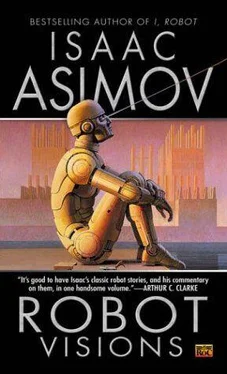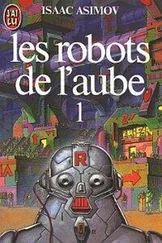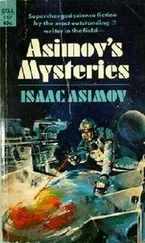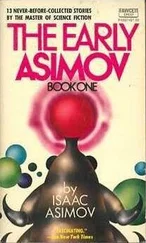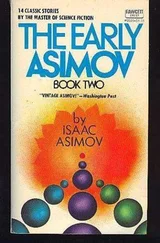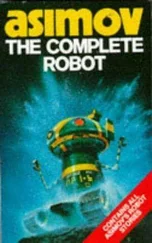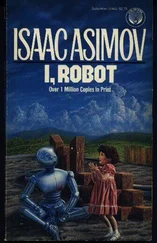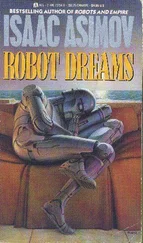Isaac Asimov - Robot Visions
Здесь есть возможность читать онлайн «Isaac Asimov - Robot Visions» весь текст электронной книги совершенно бесплатно (целиком полную версию без сокращений). В некоторых случаях можно слушать аудио, скачать через торрент в формате fb2 и присутствует краткое содержание. Жанр: Фантастика и фэнтези, на английском языке. Описание произведения, (предисловие) а так же отзывы посетителей доступны на портале библиотеки ЛибКат.
- Название:Robot Visions
- Автор:
- Жанр:
- Год:неизвестен
- ISBN:нет данных
- Рейтинг книги:5 / 5. Голосов: 1
-
Избранное:Добавить в избранное
- Отзывы:
-
Ваша оценка:
- 100
- 1
- 2
- 3
- 4
- 5
Robot Visions: краткое содержание, описание и аннотация
Предлагаем к чтению аннотацию, описание, краткое содержание или предисловие (зависит от того, что написал сам автор книги «Robot Visions»). Если вы не нашли необходимую информацию о книге — напишите в комментариях, мы постараемся отыскать её.
Robot Visions — читать онлайн бесплатно полную книгу (весь текст) целиком
Ниже представлен текст книги, разбитый по страницам. Система сохранения места последней прочитанной страницы, позволяет с удобством читать онлайн бесплатно книгу «Robot Visions», без необходимости каждый раз заново искать на чём Вы остановились. Поставьте закладку, и сможете в любой момент перейти на страницу, на которой закончили чтение.
Интервал:
Закладка:
The story deals with the possible loss of ability to do simple arithmetic through the perpetual use of computers. I wrote it as a satire that combined humor with passages of bitter irony, but I wrote more truly than I knew. These days I have a pocket computer and I begrudge the time and effort it would take me to subtract 182 from 854. I use the darned computer. “The Feeling of Power” is one of the most frequently anthologized of my stories.
In a way, this story shows the negative side of computers, and in this period I also wrote stories that showed the possible vengeful reactions of computers or robots that are mistreated. For computers, there is “Someday,” which appeared in the August 1956 issue of Infinity Science Fiction, and for robots (in automobile form) see “Sally,” which appeared in the May-June 1953 issue of Fantastic.
11. “Feminine Intuition:” My robots are almost always masculine, though not necessarily in an actual sense of gender. After all, I give them masculine names and refer to them as “he.” At the suggestion of a female editor, JudyLynn del Rey, I wrote “Feminine Intuition,” which appeared in the October 1969 issue of The Magazine of Fantasy and Science Fiction. It showed, for one thing, that I could do a feminine robot, too. She was still metal, but she had a narrower waistline than my usual robots and had a feminine voice, too. Later on, in my book Robots and Empire, there was a chapter in which a humanoid female robot made her appearance. She played a villainous role, which might surprise those who know of my frequently displayed admiration of the female half of humanity.
12. “The Bicentennial Man:” This story, which first appeared in 1976 in a paperback anthology of original science fiction, Stellar #2, edited by Judy-Lynn del Rey, was my most thoughtful exposition of the development of robots. It followed them in an entirely different direction from that in “The Last Question. “ What it dealt with was the desire of a robot to become a man and the way in which he carried out that desire, step by step. Again, I carried the plot all the way to its logical conclusion. I had no intention of writing this story when I started it. It wrote itself, and turned and twisted in the typewriter. It ended as the third favorite of mine among all my stories. Ahead of it come only “The Last Question,” mentioned above, and “The Ugly Little Boy,” which is not a robot story.
13. “The Caves of Steel:” Meanwhile, at the suggestion of Horace L. Gold, editor of Galaxy, I had written a robot novel. I had resisted doing so at first for I felt that my robot ideas only fit the short story length. Gold, however, suggested I write a murder mystery dealing with a robot detective. I followed the suggestion partway. My detective was a thoroughly human Elijah Baley (perhaps the most attractive character I ever invented, in my opinion), but he had a robot sidekick, R. Daneel Olivaw. The book, I felt, was the perfect fusion of mystery and science fiction. It appeared as a three-part serial in the October, November, and December 1953 issues of Galaxy, and Doubleday published it as a novel in 1954.
What surprised me about the book was the reaction of the readers. While they approved of Lije Baley, their obvious interest was entirely with Daneel, whom I had viewed as a mere subsidiary character. The approval was particularly intense in the case of the women who wrote to me. (Thirteen years after I had invented Daneel, the television series Star Trek came out, with Mr. Spock resembling Daneel quite closely in character-something which did not bother me-and I noticed that women viewers were particularly interested in him, too. I won’t pretend to analyze this.)
14. “The Naked Sun:” The popularity of Lije and Daneel led me to write a sequel, The Naked Sun, which appeared as a three-part serial in the October, November, and December 1956 issues of Astounding and was published as a novel by Doubleday in 1957. Naturally, the repetition of the success made a third novel seem the logical thing to do. I even started writing it in 1958, but things got in the way and, what with one thing and another, it didn’t get written till 1983.
15. “The Robots of Dawn:” This, the third novel of the Lije Baley/R. Daneel series, was published by Doubleday in 1983. In it, I introduced a second robot, R. Giskard Reventlov, and this time I was not surprised when he turned out to be as popular as Daneel.
16. “Robots and Empire:” When it was necessary to allow Lije Baley to die (of old age), I felt I would have no problem in doing a fourth book in the series, provided I allowed Daneel to live. The fourth book, Robots and Empire, was published by Doubleday in 1985. Lije’s death brought some reaction, but nothing at all compared to the storm of regretful letters I received when the exigencies of the plot made it necessary for R. Giskard to die.
Of the short stories I have listed as “notable” you may have noticed that three-”Franchise,” “The Last Question,” and “The Feeling of Power”-are not included in the collection you are now holding. This is not an oversight, nor is it any indication that they are not suitable for collection. The fact is that each of the three is to be found in an earlier collection, Robot Dreams, that is a companion piece for this one. It wouldn’t be fair to the reader to have these stories in both collections.
To make up for that, I have included in Robot Visions nine robot stories that are not listed above as “notable.” This in no way implies that these nine stories are inferior, merely that they broke no new ground.
Of these nine stories, “Galley Slave” is one of my favorites, not only because of the word-play in the title, but because it deals with a job I earnestly wish a robot would take off my hands. Not many people have gone through more sets of galleys than I have.
“Lenny” shows a human side of Susan Calvin that appears in no other story, while “Someday” is my foray into pathos. “Christmas Without Rodney” is a humorous robot story, while “Think!” is a rather grim one. “Mirror Image” is the only short story I ever wrote that involves R. Daneel Olivaw, the co-hero of my robot novels. “Too Bad!” and “Segregationist” are both robot stories based on medical themes. And, finally, “Robot Visions” is written specifically for this collection.
So it turns out that my robot stories have been almost as successful as my Foundation books, and if you want to know the truth (in a whisper, of course, and please keep this confidential) I like my robot stories better.
Finally, a word about the essays in this book. The first essay was written in 1956. All the others have appeared in 1974 and thereafter. Why the eighteen-year gap?
Easy. I wrote my first robot story when I was nineteen, and I wrote them, on and off, for over thirty years without really believing that robots would ever come into existence in any real sense-at least not in my lifetime. The result was that I never once wrote a serious essay on robotics. I might as well expect myself to have written serious essays on Galactic empires and psychohistory. In fact, my 1956 piece is not a serious discussion of robotics but merely a consideration of the use of robots in science fiction.
It was not till the mid-1970s, with the development of the microchip, that computers grew small enough, versatile enough, and cheap enough to allow computerized machinery to become practical for industrial use. Thus, the industrial robot arrived-extremely simple compared to my imaginary robots, but clearly en route.
And, as it happened, in 1974, just as robots were becoming real, I began to write essays on current developments in science, first for American Way magazine and then for the Los Angeles Times Syndicate. It became natural to write an occasional piece on real robotics. In addition, Byron Preiss Visual Publications, Inc., began to put out a remarkable series of books under the general title of Isaac Asimov’s Robot City, and I was asked to do essays on robotics for each of them. So it came about that before 1974, I wrote virtually no essays on robotics, and after 1974 quite a few. It’s not my fault, after all, if science finally catches up to my simpler notions.
Читать дальшеИнтервал:
Закладка:
Похожие книги на «Robot Visions»
Представляем Вашему вниманию похожие книги на «Robot Visions» списком для выбора. Мы отобрали схожую по названию и смыслу литературу в надежде предоставить читателям больше вариантов отыскать новые, интересные, ещё непрочитанные произведения.
Обсуждение, отзывы о книге «Robot Visions» и просто собственные мнения читателей. Оставьте ваши комментарии, напишите, что Вы думаете о произведении, его смысле или главных героях. Укажите что конкретно понравилось, а что нет, и почему Вы так считаете.
